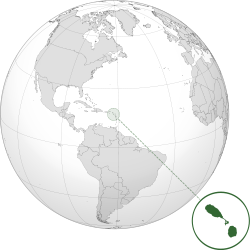Federation of Saint Christopher and Nevis | |
|---|---|
| Motto: "Country Above Self" | |
| Anthem: "O Land of Beauty!" | |
 | |
| Capital and largest city | Basseterre 17°18′N 62°44′W / 17.300°N 62.733°W |
| Official languages | English |
| Vernacular language | Saint Kitts Creole |
| Ethnic groups (2020)[1] |
|
| Religion (2020)[2] |
|
| Demonym(s) |
|
| Government | Federal parliamentary constitutional monarchy |
• Monarch | Charles III |
| Marcella Liburd | |
| Terrance Drew | |
| Legislature | National Assembly |
| Independence from the United Kingdom | |
| 27 February 1967 | |
• Independence declared | 19 September 1983 |
| Area | |
• Total | 261 km2 (101 sq mi) (188th) |
• Water (%) | Negligible |
| Population | |
• 2021 estimate | 47,606[3][4] (187th) |
• 2023 census | 54,338 |
• Density | 164/km2 (424.8/sq mi) (64th) |
| GDP (PPP) | 2023 estimate |
• Total | |
• Per capita | |
| GDP (nominal) | 2023 estimate |
• Total | |
• Per capita | |
| HDI (2022) | very high (51st) |
| Currency | East Caribbean dollar (EC$) (XCD) |
| Time zone | UTC-4 (AST) |
| Drives on | left |
| Calling code | +1 869 |
| ISO 3166 code | KN |
| Internet TLD | .kn |
| |
Saint Kitts and Nevis (/-ˈkɪts ... ˈniːvɪs/ ), officially the Federation of Saint Christopher and Nevis,[7] is an island country consisting of the two islands of Saint Kitts and Nevis, both located in the West Indies, in the Leeward Islands chain of the Lesser Antilles. With 261 square kilometres (101 sq mi) of territory, and roughly 48,000 inhabitants, it is the smallest sovereign state in the Western Hemisphere, in both area and population, as well as the world's smallest sovereign federation.[1] The country is a Commonwealth realm, with Charles III as King and head of state.[1][8]
The capital city is Basseterre, located on the larger island of Saint Kitts.[1] Basseterre is also the main port for passenger entry (via cruise ships) and cargo. The smaller island of Nevis lies approximately 3 km (2 mi) to the southeast of Saint Kitts, across a shallow channel called The Narrows.[1]
The British dependency of Anguilla was historically also a part of this union, which was known collectively as Saint Christopher-Nevis-Anguilla. However, Anguilla chose to secede from the union in 1967, and remains a British overseas territory.[1]
Saint Kitts and Nevis were among the first islands in the Caribbean to be colonised by Europeans. Saint Kitts was home to the first British and French Caribbean colonies, and thus has also been titled "The Mother Colony of the West Indies".[9] It is also the most recent British territory in the Caribbean to become independent, gaining independence in 1983.
- ^ a b c d e f "CIA World Factbook- St Kitts and Nevis". www.cia.gov. Archived from the original on 5 December 2020. Retrieved 10 July 2019.
- ^ "National Profiles". Archived from the original on 18 October 2022. Retrieved 18 October 2022.
- ^ "World Population Prospects 2022". United Nations Department of Economic and Social Affairs, Population Division. Retrieved 17 July 2022.
- ^ "World Population Prospects 2022: Demographic indicators by region, subregion and country, annually for 1950-2100" (XSLX) ("Total Population, as of 1 July (thousands)"). United Nations Department of Economic and Social Affairs, Population Division. Retrieved 17 July 2022.
- ^ a b "World Economic Outlook October 2023 (Saint Kitts and Nevis)". International Monetary Fund. October 2023. Archived from the original on 13 December 2023. Retrieved 13 December 2023.
- ^ "Human Development Report 2023/24" (PDF). United Nations Development Programme. 13 March 2024. Archived (PDF) from the original on 13 March 2024. Retrieved 13 March 2024.
- ^ "1983 Saint Kitts and Nevis Constitution". pdba.georgetown.edu. Archived from the original on 20 August 2017. Retrieved 30 August 2017.
- ^ "Enclopedia Britannica – St Kitts and Nevis". Archived from the original on 3 August 2023. Retrieved 10 July 2019.
- ^ Adkins, Leonard M. (1999). The Caribbean : a walking and hiking guide (3rd ed.). Edison, NJ: Hunter Pub. p. 178. ISBN 0585042586. OCLC 43474982.

